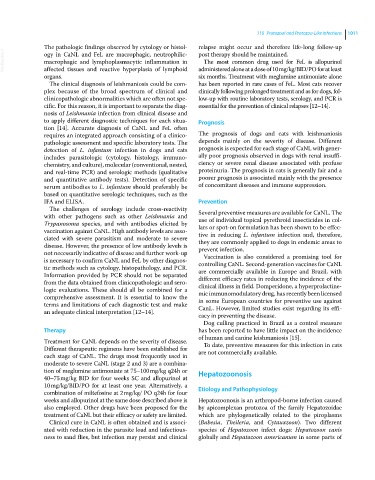Page 1073 - Clinical Small Animal Internal Medicine
P. 1073
110 Protozoal and Protozoa‐Like Infections 1011
The pathologic findings observed by cytology or histol- relapse might occur and therefore life‐long follow‐up
VetBooks.ir ogy in CaNL and FeL are macrophagic, neutrophilic‐ post therapy should be maintained.
The most common drug used for FeL is allopurinol
macrophagic and lymphoplasmacytic inflammation in
affected tissues and reactive hyperplasia of lymphoid
six months. Treatment with meglumine antimoniate alone
organs. administered alone at a dose of 10 mg/kg/BID/PO for at least
The clinical diagnosis of leishmaniosis could be com- has been reported in rare cases of FeL. Most cats recover
plex because of the broad spectrum of clinical and clinically following prolonged treatment and as for dogs, fol-
clinicopathologic abnormalities which are often not spe- low‐up with routine laboratory tests, serology, and PCR is
cific. For this reason, it is important to separate the diag- essential for the prevention of clinical relapses [12–14].
nosis of Leishmania infection from clinical disease and
to apply different diagnostic techniques for each situa- Prognosis
tion [14]. Accurate diagnosis of CaNL and FeL often
requires an integrated approach consisting of a clinico- The prognosis of dogs and cats with leishmaniosis
pathologic assessment and specific laboratory tests. The depends mainly on the severity of disease. Different
detection of L. infantum infection in dogs and cats prognosis is expected for each stage of CaNL with gener-
includes parasitologic (cytology, histology, immuno- ally poor prognosis observed in dogs with renal insuffi-
chemistry, and culture), molecular (conventional, nested, ciency or severe renal disease associated with profuse
and real‐time PCR) and serologic methods (qualitative proteinuria. The prognosis in cats is generally fair and a
and quantitative antibody tests). Detection of specific poorer prognosis is associated mainly with the presence
serum antibodies to L. infantum should preferably be of concomitant diseases and immune suppression.
based on quantitative serologic techniques, such as the
IFA and ELISA. Prevention
The challenges of serology include cross‐reactivity
with other pathogens such as other Leishmania and Several preventive measures are available for CaNL. The
use of individual topical pyrethroid insecticides in col-
Trypanosoma species, and with antibodies elicited by lars or spot‐on formulation has been shown to be effec-
vaccination against CaNL. High antibody levels are asso- tive in reducing L. infantum infection and, therefore,
ciated with severe parasitism and moderate to severe they are commonly applied to dogs in endemic areas to
disease. However, the presence of low antibody levels is prevent infection.
not necessarily indicative of disease and further work‐up Vaccination is also considered a promising tool for
is necessary to confirm CaNL and FeL by other diagnos- controlling CaNL. Second‐generation vaccines for CaNL
tic methods such as cytology, histopathology, and PCR. are commercially available in Europe and Brazil, with
Information provided by PCR should not be separated different efficacy rates in reducing the incidence of the
from the data obtained from clinicopathologic and sero- clinical illness in field. Domperidone, a hyperprolactine-
logic evaluations. These should all be combined for a mic immunomodulatory drug, has recently been licensed
comprehensive assessment. It is essential to know the in some European countries for preventive use against
terms and limitations of each diagnostic test and make CanL. However, limited studies exist regarding its effi-
an adequate clinical interpretation [12–14].
cacy in preventing the disease.
Dog culling practiced in Brazil as a control measure
Therapy has been reported to have little impact on the incidence
of human and canine leishmaniosis [15].
Treatment for CaNL depends on the severity of disease. To date, preventive measures for this infection in cats
Different therapeutic regimens have been established for are not commercially available.
each stage of CaNL. The drugs most frequently used in
moderate to severe CaNL (stage 2 and 3) are a combina-
tion of meglumine antimoniate at 75–100 mg/kg q24h or Hepatozoonosis
40–75 mg/kg BID for four weeks SC and allopurinol at
10 mg/kg/BID/PO for at least one year. Alternatively, a Etiology and Pathophysiology
combination of miltefosine at 2 mg/kg/ PO q24h for four
weeks and allopurinol at the same dose described above is Hepatozoonosis is an arthropod‐borne infection caused
also employed. Other drugs have been proposed for the by apicomplexan protozoa of the family Hepatozoidae
treatment of CaNL but their efficacy or safety are limited. which are phylogenetically related to the piroplasms
Clinical cure in CaNL is often obtained and is associ- (Babesia, Theileria, and Cytauxzoon). Two different
ated with reduction in the parasite load and infectious- species of Hepatozoon infect dogs: Hepatozoon canis
ness to sand flies, but infection may persist and clinical globally and Hepatozoon americanum in some parts of

